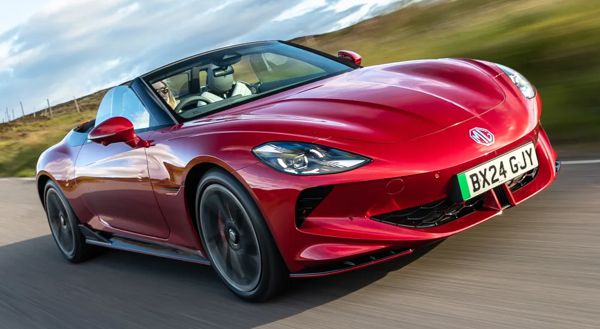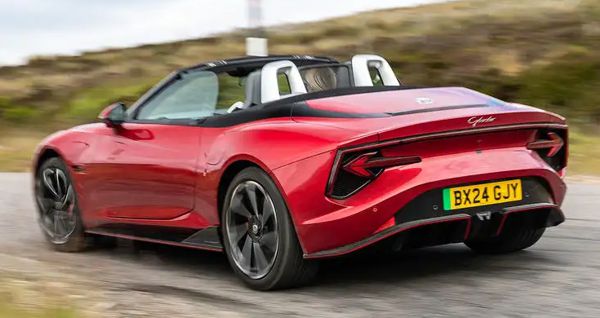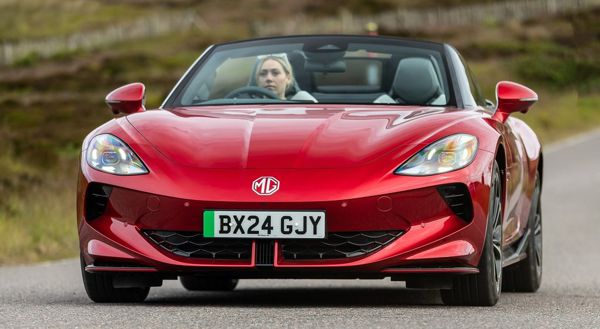Published
on 10
Aug 2024
|
All rights reserved.
|
|

|
|
Almost
20 years after the demise of MG TF, the British sports car brand
finally builds another roadster.
|
|
I remember when I went
business trip to China 20 years ago, the streets of Beijing and
Shenzhen were full of cheap Hyundais, Mk1 Volkswagen Jetta and old
Citroens. No foreign car makers were allowed to build factories there
unless they partner with local manufacturers, and they could take no
more than 50 percent stakes in the joint ventures. However, the market
potential was huge and economy was developing rapidly. Nearly all
foreign car makers you can name invested in China. They helped building
the entire supply chains, taught Chinese workers and managers how to do
quality control, transferred engineering know-how and even built design
studios and R&D centers there. Admittedly, Chinese people are
mostly smart, well-educated and hard-working. They learned the skills
quickly and started building their own brands. In addition to the
substantial investment and subsidies made by many local governments,
free lands, state-backed cheap loans, proactive investment in battery
supply chains etc., these lead to what we see today. Quoting the words
of Elon Musk, “Chinese car makers will demolish global rivals!”
While their routes to success are quite different, today’s Chinese car
makers are very much like the Japanese did in the 1980s. Having
dominated their local markets for long, they expand aggressively
overseas. They are no longer content of building cheap cars. They use
the huge capitals they earned over the past decade to upgrade their
products. They spend limitless money to hire international designers
and engineering talents. They build halo cars with stunning looks,
technology and performance to make a statement, announcing a new era to
the world. Just like the late 1980s and early 1990s when we saw the
Japanese launched incredible cars like NSX or Skyline GT-R. If there is
anything different, it is that the industry’s transition to EVs
coincides with the rise of Chinese car makers perfectly, making them
easier to leapfrog their old-school rivals.
MG Cyberster is one of these halo cars. The famous British sports car
brand, originally stood for Morris Garage, went into the hands of
Shanghai Automotive Industry Corporation (SAIC) in 2007. Part of the
old Longbridge plant of MG Rover was converted to an R&D center,
whose main job is to fine-tune the cars developed by China to suit the
taste of European motorists and comply with European regulations. The
UK operation also includes design studio, where talents like Martin
Kropp (Volkswagen Passat CC) and Oleg Son (ex-PSA and Kia interior
designer) were recruited. In 2018, it opened a 20-strong Advanced
Design studio in London. Headed by Carl Gotham, the London studio
created the Cyberster concept in 2021. It impressed the Chinese bosses
and got greenlight for production soon afterwards. The engineering work
was done in China, of course, but the final tuning got Longbridge’s
input.

|
|
Dual-motor
GT offers searing pace at affordable price, but not without
compromises...
|
|
When MG revives a 2-seat roadster, you might expect an affordable,
lightweight and fun-to-drive sports car in the mold of Mazda MX-5,
don't you? Sorry, just as the Geely-owned Smart is no longer a Smart,
the Shanghai-owned MG is no longer an MG. With no references to any
classic MG sports cars, the Cyberster is a heavyweight, powerful and
upmarket electric 2-seater.
At the first glance, its exterior design does turn heads. Long, sleek
and curvy, it could be mistaken for a Jaguar roadster. The proportion
is much healthier than BMW Z4, obviously. Moreover, it sports a pair of
electric-powered scissors doors like some supercars, just to deliver
maximum halo effect.
Inside, the cockpit design is not unlike Chevrolet Corvette, as a
prominent transmission tunnel with grab handles divides the cockpit
into 2 halves. Materials and build quality are surprisingly good.
Screen sizes are generous – perhaps too generous, because views to the
slightly angled left and right screens are partially blocked by the
steering wheel. Another portrait touch screen on the center console
facilitates climate control, which unfortunately makes simple things
complicated.
Problem is, you sit a few inches too high in the Cyberster. The battery
fills the floorpan as in most mainstream EVs, unlike Maserati which
stores batteries in the spine, so you sit “on” the car instead of “in”
it. No problem if you are driving a sedan or crossover, but this is a
roadster!
The cabin is pretty spacious, especially in terms of width. There is
also space behind the seats for luggage. However, taller drivers could
find their heads uncomfortably close to the windscreen header, and
their hairstyle ruined by buffeting.

|
|
Build
quality is surprisingly good, but you sit a few inches too high.
|
|
At over 4.5 meters long and 1.9 meters wide, it is considerably larger
than BMW Z4 and Porsche Boxster. That’s why I would compare it to
Jaguar F-Type, another powerful and heavyweight luxurious roadster. The
MG’s 2690mm wheelbase is super-long, suggesting GT cruising comfort
instead of sports car agility, but this is driven by the need to fit
77kWh of batteries into its wheelbase.
Predictably, it is heavy. Single-motor, rear-wheel-drive base model
called “Trophy” tips the scale at 1885 kg without driver, while
dual-motor, all-wheel-drive “GT” flagship adds another 100 kg. The last
MG roadster, MG TF, weighed 1100 kg only before its demise in 2005.
That car was also 600mm shorter, 300mm narrower, 70mm lower and ran a
wheelbase 315mm shorter. If there were any genes shared between them,
sorry I cannot see.
Forget about the MG heritages, see it as a rival to BMW Z4 or Porsche
Boxster would be more realistic. The Trophy offers 340 horsepower, 121
mph top speed and 0-60 mph in 4.8 seconds at £55,000, not exactly
a bargain against a six-cylinder Z4 (155 mph and 4.3 sec at £57K)
or base Boxster (171 mph and 4.5 sec at £56K). I don’t see many
people will choose the Chinese-Anglo brand instead.
More convincing is dual-motor GT, which lifts output to 510 horsepower
and capable to do 0-60 mph in merely 3.1 seconds. Surprisingly, it asks
for only an extra £5,000, pretty good value for the performance
it offers. Wonder how the Chinese can manage to sell it so cheap? Well,
the platform is shared with the mainstream MG 4 XPower, as you can see
from its 400V electrical architecture and slow, 144kW charging speed.
And no one knows how much money SAIC is willing to lose on its halo car
project...

|
|
Soft
suspension bounces heavily on challenging roads, limiting it to the
role of laid-back GT.
|
|
Nevertheless, like the MG 4 XPower, the Cyberster’s eye-popping
performance is one-dimensional. While it feels sensational to do
standing-start sprint at a pace outpacing McLaren F1, keep going and
the acceleration will tail out after triple-figure speed, eventually
settling at a terminal 124 mph. Look at Korean performance EVs: both
Kia EV6 GT and Hyundai Ioniq5 N can reach 162 mph, because 155 mph is
the minimum norm in Europe.
But the biggest problem is chassis, which is inadequate for the
performance it takes. It’s a shame that for such a powerful yet heavy
machine, MG equips it with nothing other than double-wishbone and
multi-link suspensions. There is no limited-slip differential, no
torque-vectoring active-diff, not even the simplest adaptive dampers
that you’ll find on most C-segment hot hatches. The Cyberster’s
suspension setting is soft to promote long-distance cruising
refinement. It prefers open and flat roads. When it meets twisty and
undulating roads, i.e. the kind of mountain roads that conventional
roadsters should excel, it bounces heavily. The faster you go the worse
it gets. The steering gets nervous and grip level is hard to judge. In
the end, you give up and back off.
The lighter Trophy is keener to steer, but on uneven surfaces it also
suffers from lack of composure. Without a limited slip differential,
the inside rear wheel is prone to spin when accelerating out of tighter
corners. Oversteer happens abruptly.
The best way to enjoy the car is driving it relaxingly on smoother
roads, where the near-silent powertrain excels. Make no mistake, the
Cyberster is not a sports car despite of its headline power and
performance figures, but is a comfort-oriented, laid-back-style GT.
Something like the old Mercedes SL or Jaguar XK but without their
luxury status. In a shrinking global market for roadsters, I don’t
think it will capture many sales. Then again, making money has never
been the objective of halo cars, just like the original Skyline GT-R or
NSX.
|
Verdict:    |
|